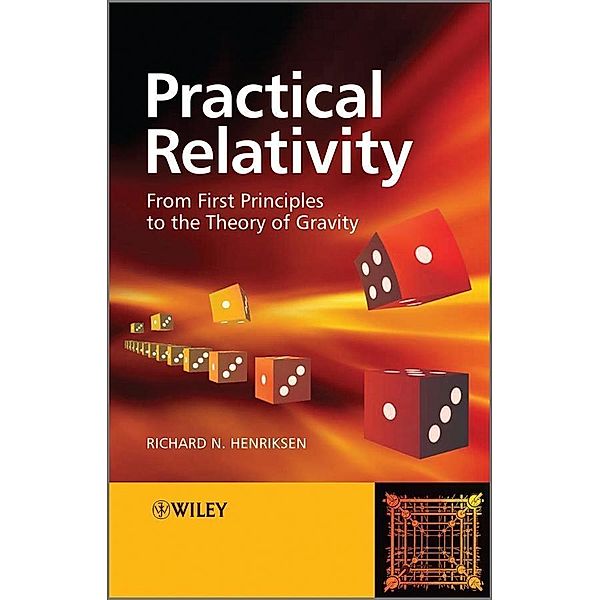Practical Relativity (PDF)
From First Principles to the Theory of Gravity
(Sprache: Englisch)
The book is intended to serve as lecture material for courses on relativity at undergraduate level. Although there has been much written on special relativity the present book will emphasize the real applications of relativity. In addition, it will be...
sofort als Download lieferbar
eBook (pdf)
47.99 €
- Lastschrift, Kreditkarte, Paypal, Rechnung
- Kostenloser tolino webreader
Produktdetails
Produktinformationen zu „Practical Relativity (PDF)“
The book is intended to serve as lecture material for courses on relativity at undergraduate level. Although there has been much written on special relativity the present book will emphasize the real applications of relativity. In addition, it will be physically designed with the use of box summaries so as to allow easy access of practical results. The book will be composed of eight chapters. Chapter 1 will give an introduction to special relativity that is the world without gravity. Implications will be presented with emphasis on time dilation and the Doppler shift as practical considerations. In Chapter 2, the four-vector representation of events will be introduced. The bulk of this chapter will deal with flat space dynamics. This will require the generalization of Newton's first and second laws. Some important astronomical applications will be discussed in Chapter 3 and in Chapter 4 some engineering applications of special relativity such as atomic clocks will be presented. Chapter 5 will be dedicated to the thorny question of gravity. The physical motivation of the theory must be examined and the geometrical interpretation presented. Chapter 6 will present astronomical applications of relativistic gravity. These include the usual solar system tests; light bending, time delay, gravitational red-shift, precession of Keplerian orbits. Chapter 7 will be dedicated to relativistic cosmology. Many of the standard cosmological concepts will be introduced, being mathematically simple but conceptually subtle. The concluding chapter will be largely dedicated to the global positioning system as an engineering problem that requires both inertial and gravitational relativity. The large interferometers designed as gravitational wave telescopes will be discussed here.
Inhaltsverzeichnis zu „Practical Relativity (PDF)“
Preface Acknowledgements Introduction Part One: The World Without Gravity 1 Non-relativity for relativists 1.1 Vectors and reference frames 2 Invariance of physical law under change of inertial frame of reference 2.1 Prologue 2.2 The theory of light or electromagnetic waves 2.3 Measurement theory and the Lorentz transformations 3 Implications: Using and understanding the Lorentz transformations 3.1 Prologue 3.2 Kinematic applications 3.3 Kinematic acceleration 3.4 Geometrical optics 4 The measure of space-time 4.1 Prologue 4.2 Metric space-time 4.3 Four-vector dynamics 5 Electromagnetic theory in space-time 5.1 Prologue 5.2 Lagrangian dynamics of an electromagnetic charge 5.3 Electromagnetism for arbitrary inertial observers Part Two: Relativity with the Gravitational Field 6 Gravitational structure of space-time 6.1 Prologue 6.2 The weak gravitational field 6.3 Constant or stationary gravitational field 6.4 Strong gravitational field
Autoren-Porträt von Richard N. Henriksen
Professor Richard Henriksen is a full professor of astrophysics at Queen's University, Kingston (Canada). He was awarded his PhD at Manchester (UK) and he has been a senior visitor at Stanford (USA), a Humbolt Fellow in Germany and Engineur/chercheur at CEA Saclay in France. Professor Henriksen has published over 125 research papers of various kinds, many of which employ relativistic concepts. Together with Geoff Bicknell, he published in the astrophysical journal one of the first papers in which the formation of primordial black holes was calculated correctly. He has extensive experience lecturing, having lectured at all graduate and undergraduate levels in physics of most types. He has in addition presented many professional colloquia and has won the Queen's University research excellence award. His areas of research range widely over the field of astronomy and astrophysics.
Bibliographische Angaben
- Autor: Richard N. Henriksen
- 2010, 1. Auflage, 280 Seiten, Englisch
- Verlag: John Wiley & Sons
- ISBN-10: 0470972033
- ISBN-13: 9780470972038
- Erscheinungsdatum: 01.09.2010
Abhängig von Bildschirmgröße und eingestellter Schriftgröße kann die Seitenzahl auf Ihrem Lesegerät variieren.
eBook Informationen
- Dateiformat: PDF
- Größe: 1.92 MB
- Mit Kopierschutz
Sprache:
Englisch
Kopierschutz
Dieses eBook können Sie uneingeschränkt auf allen Geräten der tolino Familie lesen. Zum Lesen auf sonstigen eReadern und am PC benötigen Sie eine Adobe ID.
Kommentar zu "Practical Relativity"
0 Gebrauchte Artikel zu „Practical Relativity“
| Zustand | Preis | Porto | Zahlung | Verkäufer | Rating |
|---|






Schreiben Sie einen Kommentar zu "Practical Relativity".
Kommentar verfassen